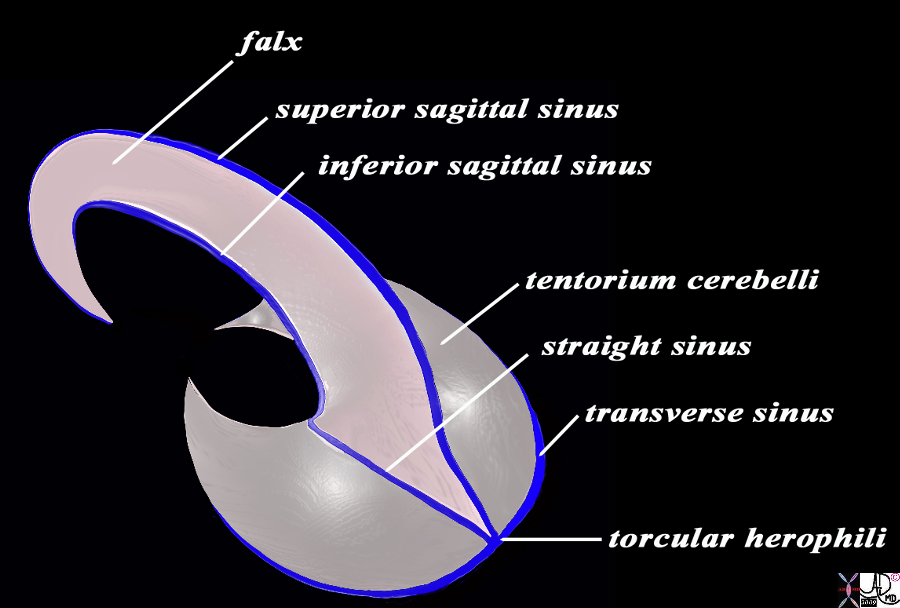The Common Vein Copyright 2010
Definition
The falx cerebri (aka falx, cerebral falx) is a an arched down fold of duramater that is found between the cerebral hemispheres in the interhemispheric fissure.
It is sickle shaped and hence its name. Anteriorly it is relatively shallow and posteriorly it deeper meaning that its craniocaudad dimensions are reduced anteriorly compared to the posterior craniocaudad dimensions. It is about 2mm thick.
Superiorly it is attached top the inner skull surface and it helps house the superior sagittal sinus which runs along the entire superior edge of the skull engulfed by the divided dura and attaches anteriorly on the superior surface of the crista galli as it arches with the falx under the frontal lobe.
The lower margin is free and it houses the inferior sagittal sinus.
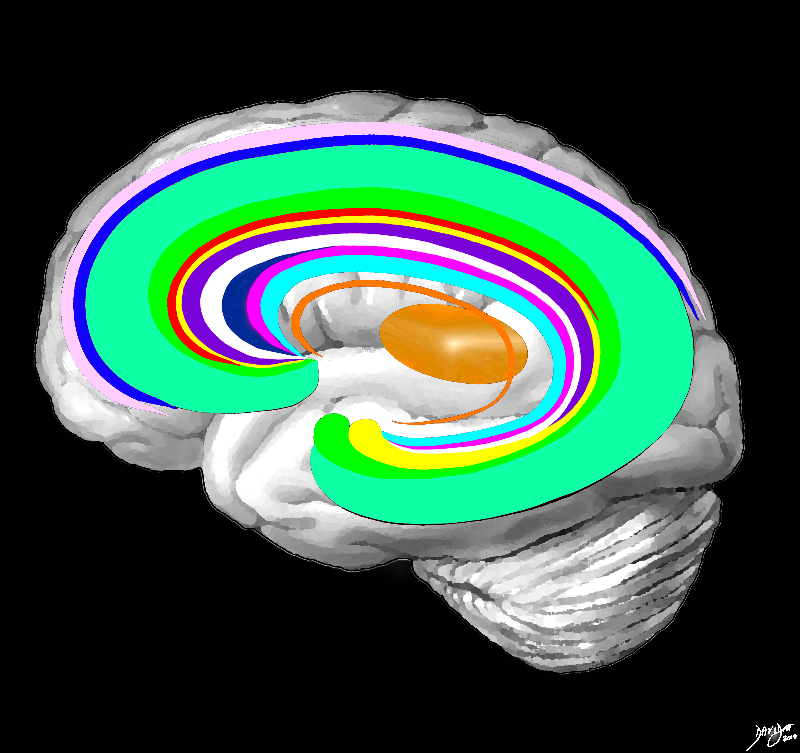 The Falx (pink) Superiporly Positioned “Inverted C” Situated Just Bneath the Skull The Falx (pink) Superiporly Positioned “Inverted C” Situated Just Bneath the Skull |
|
The forebrain has most of its components aligned in a series of inverted c- shaped rings starting from the outer membranes that culminate in the falx (pink), then extending inward smaller inner rings with each intimately connected to the others. The thalamus (dull orange) appears diagrammatically as the centre of these rings as seen from the sagittal view The outer ring is the falx (pink) followed by the sagittal sinus (blue) cerebral cortex (light green), cingulate gyrus (bright green) superiorly which becomes the parahippocampal gyrus inferiorly. The red ring represents the distribution of the main portion of the anterior cerebral artery. Next is the yellow ring which is the supracollosal gyrus (indusium griseum) superiorly and the hippocampus inferiorly. This is followed by the corpus callosum (purple) which enables the white ring of white matter to connect between hemispheres. The next ring is the thin bright pink ring which represents the fornix superiorly and the fimbria inferiorly. The innermost ring (light blue) represents the lateral horns of the ventricular system. The basal ganglia run just lateral to the lateral ventricles. The navy blue arrow headed structure is the septum pellucidum. Courtesy Ashley Davidoff copyright 2010 all rights reserved 83027b04g03.8s |
|
Dural Sinuses, Falx and Tentorium |
|
In this diagram the falx and the tentorium are exemplified together with their relationships to the dural sinuses. The image is drawn in a semisagittal plane showing the basic plan of the dural sinuses and relationship to the tentorium and falx. Note the sickle shaped falx posterior end having a greater craniocaudad dimension than the anterior end. The curved anterior aspect enables the falx to attach to the crista galli anteriorly as it proceeds under the frontal lobe. The tentorium cerebelli divides the brain into supratentorial and infratentorial structures. They are closed posteriorly and open anteriorly allowing the midbrain to pass through into the posterior fossa In the midline the straight sinus is enclosed and posteriorly the torcular herophili is present The superior sagittal sinus runs on the superior aspect of the falx and abuts the vertex of the skull. It usually empties into the right transverse sinus. The inferior sagittal sinus runs on the inferior aspect of the falx and empties into the straight sinus which in turn tends to Courtesy Ashley Davidoff MD Copyright 2010 All rights reserved 98057b09.9sL |
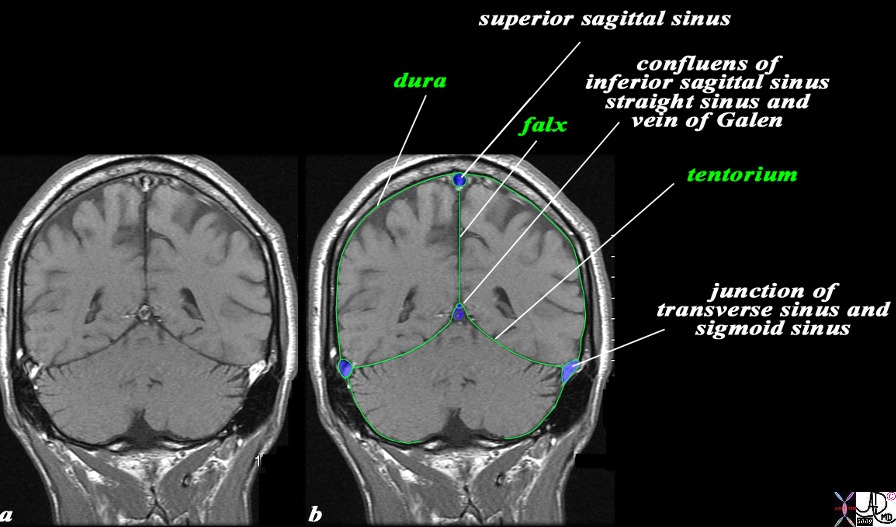 The Relationship of the Dural Sinuses and The Dura in the Coronal Plane The Relationship of the Dural Sinuses and The Dura in the Coronal Plane |
|
The overlay outlines the dural sinuses (blue) and the dura (green) in this coronal T1 weighted normal MRI sequence. The peripheral dural sinuses include the superior sagittal sinus, the laterally placed junction of the transverse sinus and straight sinus, and the confluens of the inferior sagittal sinus which runs on the inferior surface of the falx and the straight sinus which lies on the posterior and superior surface of the tentorium overlying the cerebellum. The dura is outlined in green and it splits to enclose the dural sinuses and also forms the tentorium. The dura splits at the vertex to encompass the superior sagittal sinus and then extends down in the interhemispheric fissure to form the falx, splits again to encompass the inferior sagittal sinus anteriorly and straigt sinus posteriorly, and then spreads out to form the tentorium. The thin black T1 dark layer outward of the dura is the inner cortical bone, and is followed by the T1 bright fat containing marrow of the skull. Next is the thin black T1 dark outer cortical bone, followed by a thick layer of T1 bright subcutaneous fat, and then a thin layer of isointense (to soft tissue) skin layer. Image Courtesy Ashley Davidoff MD Copyright 2010 All rights reserved 98170c04.9Ls |
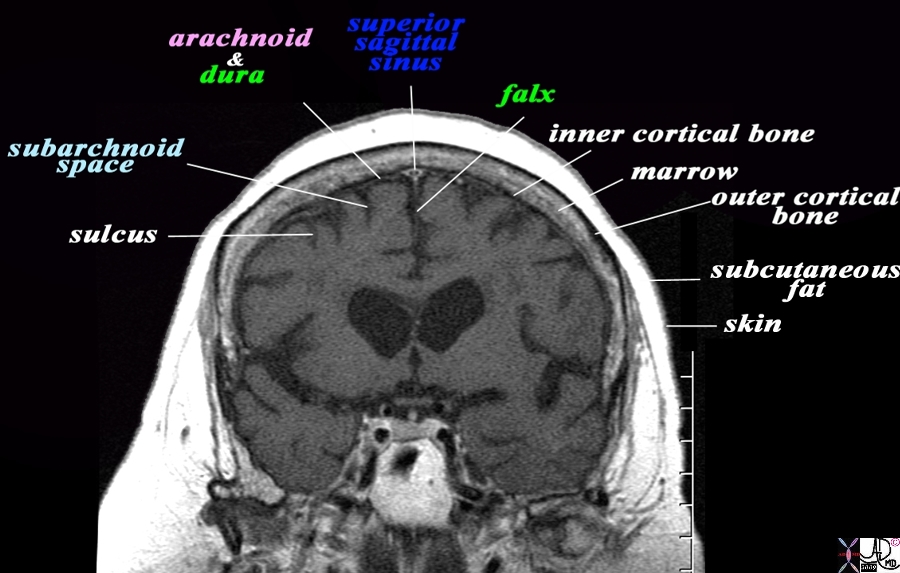 The Falx in the Interhemispheric Fissure The Falx in the Interhemispheric Fissure
Relationship with the Superior sagittal Sinus |
|
The coronal T1 weighted MRI reveals demonstrates some of the anatomical features of the meninges and their relations The sulci are seen as T1 dark CSF containing fissures in the brain substance. The pia is too thin to see but would be adherent to the brain surface. The space that contains the CSF is called the subarachnoid space (light blue). The very fine T2 bright membrane seen on the surface of the brain is a combination of arachnoid (pink) adherent to the two layers of the dura (green). The outer layer of the dura acts as the inner periosteum and is adherent to the skull. The dura splits at the vertex to encompass the superior sagittal sinus and then extends down in the interhemispheric fissure to form the falx. The thin black T1 dark layer after the arachnoid and dura is the inner cortical bone, and is followed by the T1 bright fat containing marrow of the skull. Next is the thin black T1 dark outer cortical bone, followed by a thick layer of T1 bright subcutaneous fat, and then a thin layer of isointense (to soft tissue) skin layer. Courtesy Ashley Davidoff MD Copyright 2010 All rights reserved 71422.800bL01.9 |
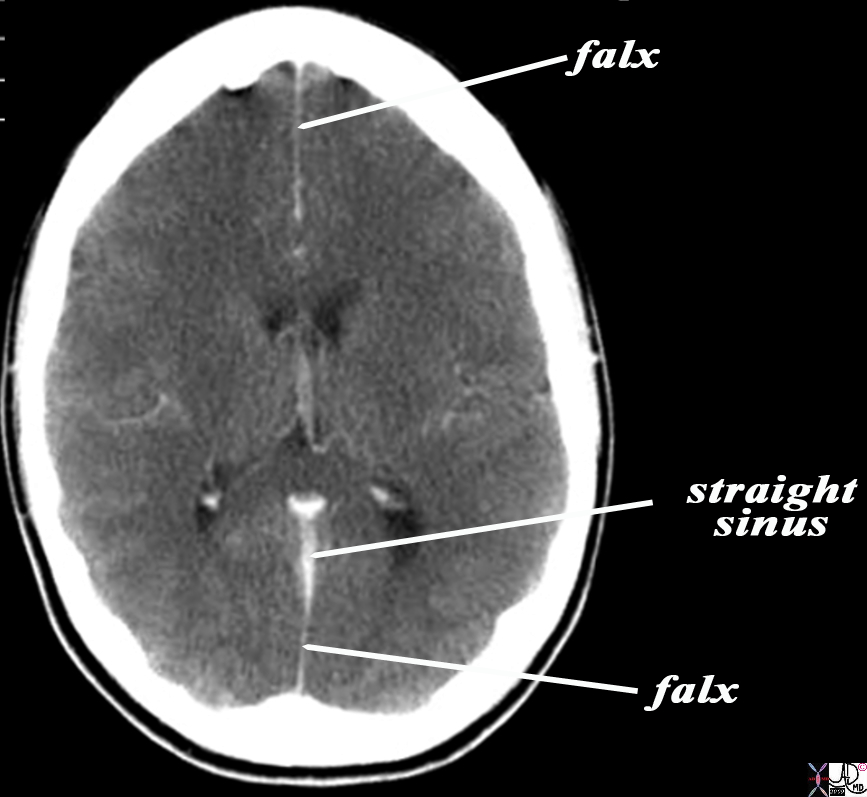 The Falx – Contrast Enhanced CT Scan The Falx – Contrast Enhanced CT Scan |
|
The enhanced CTscan is from a 24year old female with headaches, and was found to be a normal scan. Illustrated is the normal falx seen in the interhemispheric fissure anteriorly and posteriorly where its front edge receives the straight sinus. Courtesy Ashley Davidoff MD 89711L.8s |
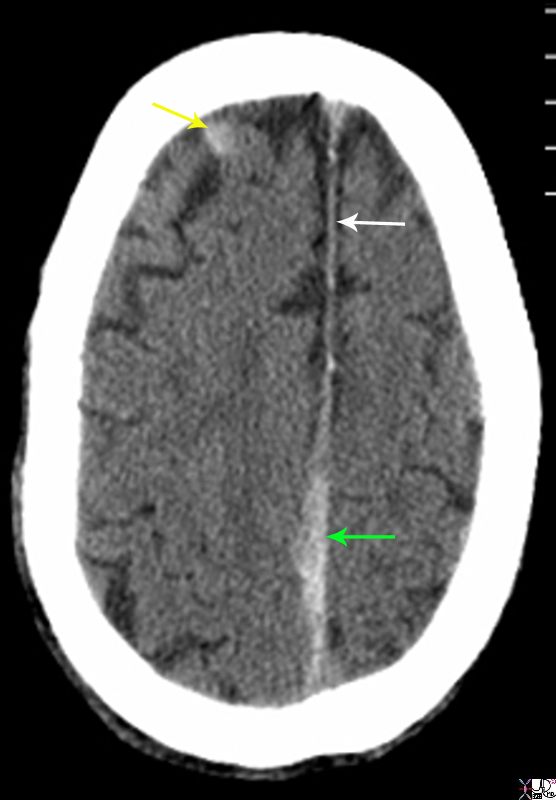 Acute Falcine and Frontal Subdural Hemorhage Acute Falcine and Frontal Subdural Hemorhage |
|
The non enhanced CTscan is from a 80 year old male on coumadin who sustained trauma to the head. There are two acte subdural hemorrhages. The first is a falcine subdural (green arrow) that has resulted in thickening irregularity and increased density of the falx near the vertex. This is contrasted to the normal falx anteriorly (white arrow) The second acute subdural is in the right frontal region (yellow arrow). Courtesy Ashley Davidoff MD Copyright 2010 89283.8sL |
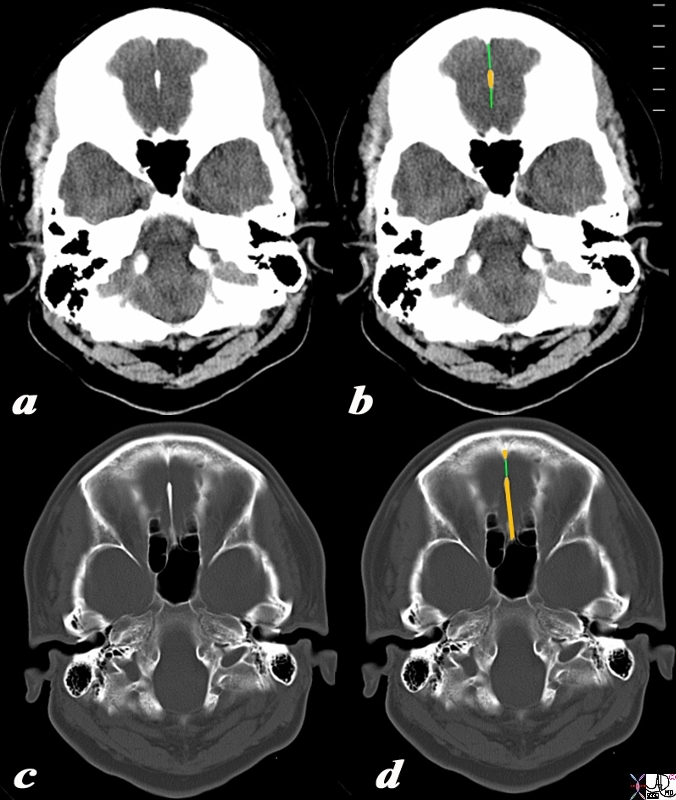 Anterior and Inferior Attachment of the FAlx to the Crista Galli Anterior and Inferior Attachment of the FAlx to the Crista Galli |
|
The CT scan in axial projection reveals the attachment of the falx to the crista galli. The crista galli (“crest of the cock”) is overlaid in orange and the under surface of the falx (green) is attached to the crista. Images a and b are soft tissue windows and c and d are bone windows. Image Courtesy Ashley Davidoff MD Copyright 2010 All rights reserved 98480cL.8s |
References
Yoganandan, Narayan Pintar, F, Larson S, Sances, A Frontiers in head and neck trauma: clinical and biomechanical IOS Press Amsterdam 1998

